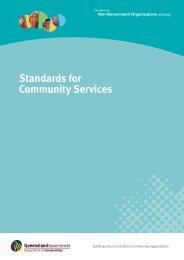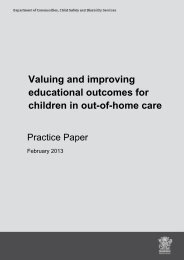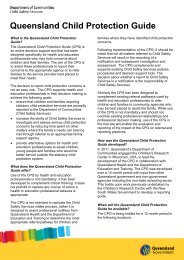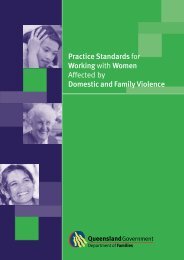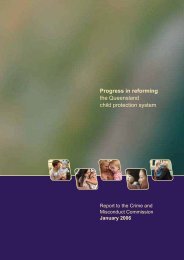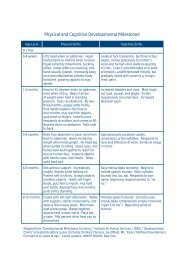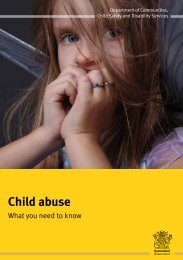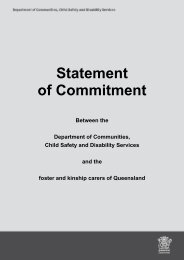Housing and Support Program (HASP): Final Evaluation Report
Housing and Support Program (HASP): Final Evaluation Report
Housing and Support Program (HASP): Final Evaluation Report
Create successful ePaper yourself
Turn your PDF publications into a flip-book with our unique Google optimized e-Paper software.
58<br />
Section 6 The ability of the program to maintain clinical functioning <strong>and</strong> provide<br />
an acceptable quality of life for those supported by the program<br />
6.5 Perceptions of future improvement<br />
in clients — Case Managers versus<br />
support workers<br />
Case Managers <strong>and</strong> support workers were also asked<br />
to consider the statement ‘the functioning of <strong>HASP</strong><br />
clients will continue to improve in the next six months’<br />
(graph below).<br />
Fig. 6.3 Change in client functioning —<br />
past six months versus next six months<br />
Percent<br />
100<br />
80<br />
60<br />
40<br />
20<br />
0<br />
Legend<br />
Strongly<br />
agree<br />
Sixty-six percent (66%) of Case Managers indicated<br />
that the functioning of their <strong>HASP</strong> clients would continue<br />
to improve in the future. In contrast, 81% of support<br />
workers believed that the functioning of <strong>HASP</strong> clients<br />
would continue to improve in the future.<br />
<strong>Final</strong> <strong>Evaluation</strong> <strong>Report</strong><br />
Agree<br />
Case<br />
Managers<br />
Neither<br />
<strong>Support</strong><br />
workers<br />
Disagree<br />
Strongly<br />
disagree<br />
The support workers who felt that clients would<br />
continue to improve suggested that clients had<br />
someone to talk to, they received positive feedback<br />
<strong>and</strong> encouragement from staff, <strong>and</strong> clients had their<br />
own homes in the community. Receiving a <strong>HASP</strong><br />
package <strong>and</strong> the dedication of all staff/agencies<br />
were also seen as likely to contribute to ongoing<br />
improvement in <strong>HASP</strong> clients. Case Managers felt<br />
that while the NGO sector would continue to contribute<br />
to client functioning, gains in functioning would be<br />
limited by the severity of disability in some clients.<br />
6.6 Changes in Mental Health Act<br />
(MHA) status<br />
The status of clients under the Mental Health Act on<br />
entry into <strong>HASP</strong> was accessed using data contained<br />
in the CIMHA database. This information was then<br />
compared with the status of clients at the point of<br />
data collection (Mar–June 2010). Data for 76 clients<br />
was available for both time-points. Over the study<br />
period, restrictions placed on clients had been<br />
signifi cantly relaxed (Chi sq. = 12.59, p = 0.002).<br />
The proportion of clients on Involuntary Treatment<br />
Orders (ITOs) decreased from 46% to 22%, while the<br />
proportion of clients with voluntary status increased<br />
from 43% to 70% (Table 6.2).<br />
Table 6.2 Changes in mental health status<br />
of <strong>HASP</strong> clients<br />
MHA status on<br />
Admission to <strong>HASP</strong><br />
(n=76)<br />
Voluntary 33 (43.4%)<br />
ITO 35 (46.1%)<br />
Forensic 8 (10.5%)<br />
MHA status<br />
at end of June 2010<br />
(n=76)<br />
Voluntary 53 (69.7%)<br />
ITO 17 (22.4%)<br />
Forensic 6 (7.8%)



